Like Indiana Jones, I was on a quest. I packed my trusty tools—digital recorder, notebook, name cards, parking stickers—in my Toyota hybrid SUV and headed off on the 16-mile trek to the University of Washington campus, up 405 and across the 520 bridge, braving rush-hour traffic with the ultimate commuter's aid, KUOW. My grail: to unlock the secrets of just how the U Dub impacts our local economy. To achieve it, I needed to consult the experts.
Living deep in Husky territory, I am an outsider. That’s one reason I had been chosen—to bring fresh eyes to this age-old question. As a former Business Week reporter, I had interviewed UW experts. I had even taken evening classes in fiction writing. But my main exposure to the campus was, like that of Jane Q. Public, to attend lectures at Kane Hall, view exhibits at the Burke and marvel at the wild profusion of cherry blossoms in the Quad each April. This is how most local residents see the UW—as a cultural resource, a sports powerhouse and a center of learning that attracts brilliant people to Seattle, many of them quoted on the evening news.
The day I began my expedition, purple flags fluttered along the streets near campus, spelling out its many impacts: culture, health, education, environment, economy. I scribbled notes at every stoplight. It brought back the thrill of my own student days, the cool new stuff to learn behind every classroom door.
The influence of the University is far broader than economic—that’s the message I got from the provost herself. I started at the top-the third floor of Gerberding Hall. Phyllis Wise greeted me with a warm smile, a firm handshake and a scientist’s immediate focus on hard data. I felt windblown and flustered compared to her calm manner, pearl necklace and perfectly coiffed black hair. She got straight to the point.
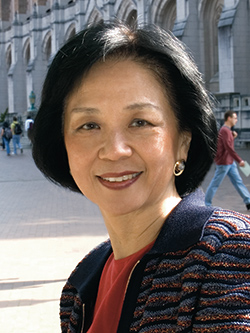
Phyllis Wise
“Cities that are the homes of major research universities are completely different,” she told me. And she should know, since she’s taught physiology in Baltimore; Lexington, Ky.; and Davis, Calif.
Having a successful, highly respected research university “puts a whole different flavor in the city. It has a sense of youth because the students are young, naive, dreaming, planning, thinking that they can be anything.” Out of the 300,000 living UW alumni, about 65 percent are still in the region, which has a tremendous impact on the intellectual power of the community. It is no accident, she notes, that many Seattle companies, such as Costco, REI, Amazon and Starbucks, are innovative in their business approach. More than 5,000 alumni work for Boeing and more than 1,000 work for Microsoft.
“Discovery is what we’re all about. It’s thinking, risking, taking avenues that people haven’t even thought about before, instead of doing it the same old way.”
The shoals of economic impact, though, are terra incognita for most academics. “Thirty years ago, the way you measured your success was by the number of manuscripts your faculty and students published in peer-reviewed, highly respected journals,” she said, admitting to belonging to that generation. “Now, it’s being measured not only by that but by the number of patents, licensing and small companies that are started.”
Research is what generates those patents, and the UW recently announced terrific news: total research dollars awarded in fiscal 2007 surpassed $1 billion. I already knew that the UW ranks second only to Johns Hopkins in attracting federal research dollars for science and engineering. Bragging rights, indeed.
Four stories down, in a “daylight basement” office of Gerberding Hall, the UW’s red-headed vice provost for research, Mary Lidstrom, fixed her brown eyes on me as she explained the sobering facts behind this success. In recent years, federal funding for research has flattened. Since 2005, in real, inflation-adjusted terms, the UW’s research funding has actually dropped. Yeowch!
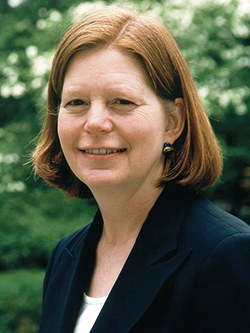
Mary Lidstrom
In the five years starting in 1998, Congress doubled federal spending for the National Institutes of Health (NIH). Because of its cutting-edge medical research, the UW’s research revenues also nearly doubled during those years. But federal funding stopped growing in 2003 and set off a crisis in the nation’s labs. “It’s been a very, very difficult situation,” said Lidstrom, a chemical engineering professor who also co-directs the NIH-funded Microscale Life Sciences Center.
First, junior researchers are discouraged when they cannot get funding, and many students decide not to go into research. Second, professors are reluctant to propose high-risk research. “What keeps the U.S. economy pushing ahead of other countries in high-tech applications is these transformational breakthroughs,” Lidstrom explained. “You need that undercurrent of really high-risk, high-payoff research.”
Not only are funds tight, but many other public universities, including Wisconsin and UCLA, receive about the same amount as the UW in overall research funds because they get much more cash from foundations, industry and their states. Until the May 2005 approval of the state’s Life Sciences Discovery Fund, the state of Washington ranked 47th in state funding for research.
But there is good news, too. At least $30 million in research dollars each year goes toward improving educational instruction and training, Lidstrom said. More than 4,000 undergraduate students also get to work in professors’ labs. And many federal agencies mandate programs to reach out to surrounding communities, such as disadvantaged high school students and local school teachers.
“Research itself is big business,” said Lidstrom. One billion dollars hires a lot of people—about 7,600. “These are high-paying jobs, skilled workers.” The money these researchers spend locally generates an additional 34,000 jobs in the surrounding economy.
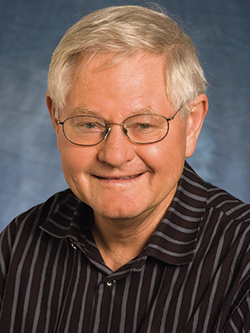
Bill Beyers
Next, I walked across “Red Square” to the office of Geography Professor Bill Beyers, ’62, ’67. It was the first week of classes, and students were rushing by with packs on their backs and wires dangling from their ears. Unlike Wise and Lidstrom, who have held their administrative jobs for only two years, Beyers has been teaching in the UW’s geography department since the time of Chief Seattle. Well, since 1967. He’s the guru on economic impact, having done studies for the Mariners, the Arts Council and the Technology Alliance.
In Smith Hall, I climbed to the fourth Boor and followed a winding hallway back around a corner. Beyers’ office amazed me. Papers and books and ancient documents were stacked so high I had to shout to see if the professor was in. I followed a narrow corridor between stacks and found him at his desk, crouching over a laptop, gray hair sticking up at odd angles. “Yes?” he smiled from behind smudged glasses.
I had done my homework. In the University’s latest annual report, from 2005-06, I had found my data points:
- Number of students at three UW campuses: 43,428 (fall 2005)
- Faculty and staff: 27,897 (full-time equivalent)
- Total spending: $2.9 billion
Professor Beyers told me no formal economic impact study had been done on the University since 1994, when KPMG Peat Marwick conducted a study that “was not received well.”
He immediately grabbed my data and jumped into a quick analysis, checking a national website for multipliers. You need to look at the UW’s direct spending on dorms, food services, research, the Burke Museum, etc. Then you calculate the indirect effect, the spending of students and faculty on housing, groceries and dorm decorations from Bed Bath and Beyond. Then you factor in visitors to the University, athletic events, alumni giving and the spending at the University’s two hospitals. Patient services brought in nearly $800 million in revenues.
Pretty soon, my mind was spinning. Multipliers, ratios, coefficients, matrices, the need to aggregate and regionalize. “It’s hard to get hard facts that no one can dispute and run with,” he said at one point. I’ll say.
Reeling, I stumbled out of his office, clutching my notebook for dear life. It’s about stretching your brain, I told myself. That’s what the students here do every day.
Back at home, I tried to straighten it all out, this time by phone with Dick Conway, ’71, another well-known Seattle economist. “It’s not difficult,” he said. “But there are a couple of traps.” The biggest trap: Lots of the money the UW spends comes from tuition and state funds, so it’s money that the taxpayers of Washington might be spending in other ways. “The economic impact of anything stems from money that comes from outside,” he said.
So you need to look at tuition from foreign and out-of-state students and figure out how many of those hospital patients are from out of state. With a few back-of-the-envelope estimates, Conway calculated that roughly $50,000 per UW employee goes back into the local economy.
The UW Office of lnstitutional Studies has determined that the University’s 28,000 employees generate a total of 66,689 jobs. Using a multiplier based on the service industry, the UW generated roughly $6 billion in total economic activity last year from its $2.9 billion in spending.
Most “new money” is the $1 billion in research funding. Aside from the Gates Foundation awards, almost all comes from outside the state, and most of it is spent within the state.
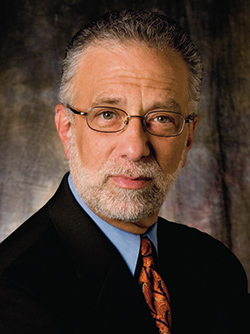
Norm Arkans
“That’s imported money into the state,” said Norm Arkans, ’73, ’75, the UW’s executive director for media relations and communications. “It’s a clean industry—doesn’t pollute very much. And it’s contributing a lot to the diversification of the state’s economy.”
Chang Mook Sohn, the state’s chief economist, agreed. “It’s just like exporting our intellectual property,” he said. The state allocated $373 million for the University last year. The return on that investment has been enormous. “From a pure economic standpoint,” said Sohn, “money allocated to higher education is more productive” than many other uses of state money.
I had collected many nuggets, but still lacked the gemstone. It’s not just about researchers in their labs or professors remodeling their homes or students buying pizza. The most powerful impact is in the way that research breaks out of the lab and helps create products we use.
To find out more, I went off campus to see the business guys—first to the offices of Washington Research Foundation, overlooking Lake Union. Its chief executive, Ron Howell, joined it in 1989, before his black hair developed a distinctive white streak. This foundation collects fees from companies that use UW technology and plows most of it back into the University. It was founded in 1981, just after a new federal law, the Bayh-Dole Act, allowed universities to cash in on the technical breakthroughs of their researchers. A local entrepreneur, W Hunter Simpson, ’49, had headed a company, Physio-Control, which made products derived from UW research. Simpson and venture capitalist Thomas J. Cable set up the foundation to make sure that the UW benefited from such commercializations in the future.
They struck gold. A biology professor named Ben Hall had been working with yeast and created a process to make yeast produce human proteins and antigens used in vaccines. Pharmaceutical companies then used his method to make insulin and vaccines for hepatitis B and, most recently, HPV, human papilloma virus. That’s the shot they’re recommending for girls and women, age 11 to 26, to prevent cervical cancer. It’s ghastly expensive, but, as a mother, I made sure my daughter got it.
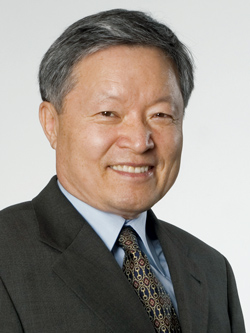
Chang Mook Sohn
Every time any girl gets the HPV vaccine, or anyone gets the “hep B” vaccine, money flows to the University of Washington through the foundation. Over the past 25 years, the foundation has paid the UW $160 million in licensing fees, more than 80 percent from the Hall patent. The UW is honoring him this year by naming a new facility the Benjamin Hall Interdisciplinary Research Building. Additionally, because of UW licensing revenues, the Washington Research Foundation has been able to make another $28 million in gifts to the UW to support a variety of research projects, graduate and undergraduate fellowships, and endowments for faculty.
In 1993, the UW decided to do all its own licensing through UW Tech Transfer. But the Washington Research Foundation continues investing in startups-an undertaking too risky for a university. One such company, Ultreo, sells an ultrasonic toothbrush, one step beyond the Sonicare toothbrush that also came out of UW research. Another company, Farecast, uses computer algorithms to predict airfares. The companies the foundation invests in now employ several hundred people, mostly in this region.
My quest took me, finally, to the corporate-like offices of Jim Severson, vice provost for intellectual property and technology transfer, near Roosevelt and 45th Street. Here I found what I had been searching for: the hard numbers that show the greatest impact the University has on the local economy. Severson, with a Ph.D. in physiology, has a businessman’s laserlike focus on results. When he took the job in 2003, it had been vacant for 15 months.
Since then, he has become “the closer”—signing many agreements with companies to commercialize technology developed at the University. His office encourages researchers to disclose innovations, 335 of them in fiscal 2007. He then files patents for them, as many as 166 in 2007. There are also copyright filings for software and other intellectual properties. But the biggest wins have been the many licensing agreements completed, since that shows a future stream of revenue: This past year, UW Tech Transfer negotiated almost 200 licenses and options for new technologies, nearly twice as many as two years earlier. In terms of licensing agreements signed, the UW is among the top five universities in the country, Severson said.
Although the University does not invest directly in startups—that could get sticky—Severson began a program, called LaunchPad, to connect researchers with business experts. And working with Washington Research Foundation, he provides “gap” funding to researchers whose innovations need a little more work before they can be licensed. As a result, the number of start-up companies emerging from the UW has gone from only three in fiscal 2005 to 10 in 2006 and 11 this past year.
Altogether, 235 start-up companies have emerged from the UW, not just in medicine but in engineering, software and materials science. These companies tend to set up shop in the state to remain close to the University, says Severson. They hire locally, lease office space and, in some cases, set up manufacturing facilities.
It also pleases local venture capitalists. “Eight of the companies we’ve invested in have come from the Department of Computer Science and Engineering,” said Tom Alberg, managing director of Madrona Investment Group. When he asked local software companies to help fund the department’s new building, even non-Huskies realized how much they benefited by hiring UW computer science graduates. “To succeed, technology companies need three things—money, entrepreneurs and innovative ideas—and the UW is one of the main sources of innovative ideas.”
After achieving my grail, I headed to Ly’s Donuts to decompress with a coffee and a maple bar. There’s no denying that UW’s spending spreads prosperity out into the city. It attracts high-tech companies who want to be close to its technology and talented graduates. Seattle has become a hotbed for start-up creation because the UW has aggressively pushed its inventions out into the world.
And outsiders like me benefit—not just from the robust local economy but from life-saving vaccines, effective new toothbrushes and smoother traffic flows. With that, I’m ready to face the 520 bridge congestion and drive home.